|
|
 |
|
|
|
 |
 |
|
|
 |
The Gulf Stream is not going to be disrupted
... but what changes can be expected in the North Atlantic?
In wide parts of Europe the climate is influenced by mild air from the ocean. The energy is transported by the Gulf Stream from Central America. Certainly, there is a great interest in the question of whether something could change in these conditions due to climate change. New results from research are often picked up by media and sometimes cause worries which are based on misunderstandings.
|
|
The Gulf Stream is wind driven, the North Atlantic Drift is not
The actual question is concerning the North Atlantic Drift, a Northern branch of the Gulf Stream. It is in particular responsible for the mild temperatures in Northwest Europe. The Gulf Stream is a wind driven ocean current. It cannot be disrupted simply by changes in the density of the water.
|
Deep water formation in the North Atlantic
The North Atlantic passing into the polar sea plays an important role in the global ocean circulation. Here, two branches of the Gulf Stream extend towards the North. The water masses cool down and become saltier by ice formation, increase in density and sink down in the Labrador Sea and in the Greenland Sea.
|
 |
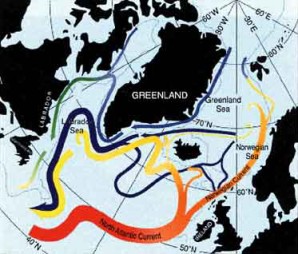 |
 |
|
Fig 1: The map shows warm currents arising from the Gulf Stream and extending to the Northern polar sea. Source: Ocean World – Texas A&M University
|
|
 |
 |
|
Fig 2. Deep water formation takes place at two locations in the North Atlantic, in the Labrador Sea and in the Greenland Sea. Since the water is colder in the Greenland Sea, it flows back in two layers of different depth. Source: V.Byfield / British National Oceanography Centre, Southampton
|
|
 |
Deep ocean water forms. This flows in deeper layers back towards the equator. In particular the turnover between Norway and Greenland has the consequence that warm surface water is carried relatively far to the North. The benefit for the West coast of Norway is a mild climate compared to other regions of the same latitude.
|
|
Changes in the past
We know from Studies of climate changes during the last 120,000 years, that there is a coupling between the formation of deep water in the North Atlantic and the change of the climate in this region.
Seen over time scales of many tens of thousands of years, there are three different states in the North Atlantic ocean circulation: the warm current advances further to the North (interglacial), less to the North (ice age) or is not existing (so called Heinrich event). A mountain ridge in the Atlantic marks the border between those areas the North Atlantic Drift reaches in glacial times or interglacials. Here, the ocean is less deep and Iceland and the Faroe Islands even loom out of the water. In the figures this border is marked in bold black dots.
|
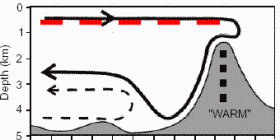 |
 |
Profile: in warm times, as we have now, the north atlantic stream reaches beyond the 'barrier' and brings warm water to the north of Europe. |
|
 |
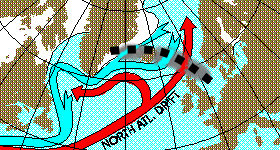 |
 |
Map of the profile on the left: For mid and northern Europe warm water is transported far to the north and warm winds are generated if air goes over the oceans to the continent. |
|
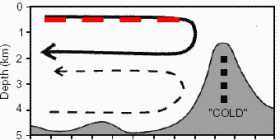 |
 |
|
During ice ages the warm stream stops in front of the 'barrier'. Further to the north the sea is covered by ice.
|
|
 |
During the ice ages, as well as during the present warm time, an ocean current goes up to a certain limit to the north. The water penetrates slowly into cold regions and ice is formed. The remaining water bearing the ice becomes saltier and therefore heavier and due to the decreasing temperature in the polar region, the surface water also becomes heavier. Finally it sinks (black arrow downwards in the profiles) and forms 'deep water'.
|
|
When is the North Atlantic Drift disrupted?
|
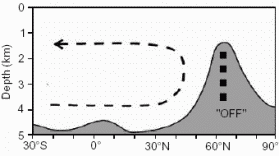 |
 |
|
The so called 'Heinrich Modus' is a state, when deep water is not formed anymore. The current stops.
Graphics: modified by Elmar Uherek, original: Stefan Rahmstorf in Nature
|
|
 |
While the ice is melting in a period of continuous warming (for example at the end of an ice age), too much fresh water from the molten ice can sometimes mix into the North Atlantic. Furthermore, the surface water becomes warmer, while the deep sea is still cold. The water cannot sink. In this case the ocean circulation may temporarily stop in the respective region. The circulation is temporarily disrupted. We call this a 'Heinrich event'.
|
|
Estimations for the future (IPCC 2007)
At present, scientists are not able to reliably forecast how the North Atlantic Drift is going to change under the conditions of climate change. It is expected that the current will slow down, since the surface water no longer gains so much density as before. The ocean surface becomes warmer, the ice formation less and the dilution by fresh water increases. Fresh water comes not only from the melting glaciers of the Greenland ice shield, but also from the increasing rainfall in this region. A density loss in the surface water has been observed over the period 1965 - 2000. On the other hand, the variation in the ocean stream over recent decades have been so strong and irregular, that there is no estimation possible of whether the water transport to the North might have been changing.
If a decrease in heat transfer to Northern Europe should really occur (this is hardly expected until 2100), global warming would in any case still counteract the related cooling.
|
|
 |
|







